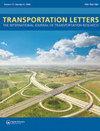高速铁路乘客列车选择偏好实证研究:以南宁-广州铁路和南宁-北海铁路为例
IF 3.3
3区 工程技术
Q2 TRANSPORTATION
Transportation Letters-The International Journal of Transportation Research
Pub Date : 2025-05-28
DOI:10.1080/19427867.2024.2391662
引用次数: 0
摘要
本文对细分市场下高铁乘客的列车选择偏好异质性进行了系统研究,以了解他们的列车选择偏好。本文章由计算机程序翻译,如有差异,请以英文原文为准。
An empirical study on train choice preferences of high-speed railway passengers: the case of Nanning-Guangzhou railway and Nanning-Beihai railway
This paper presents a systematic investigation of the train choice preference heterogeneity of High-Speed Railway (HSR) passengers under market segmentation to understand their train choice comprehensively. A stated preference survey was conducted for the Nanning-Guangzhou Railway and Nanning-Beihai Railway. Latent Class Analysis (LCA) was employed to identify homogeneous subgroups and segment the passenger market of each line into three segments: private travelers with a long total duration (PTLTD), business travelers (BT), and private travelers with a short total duration (PTSTD). Mixed Logit (ML) models were constructed for each subgroup sample to assess passengers' preferences in train choice. The results show that each class exhibited unique characteristics and preferences, and train fare and running time, departure date and time, and train frequency were statistically significant factors affecting train choice. This study can furnish theoretical and decisional support for HSR operators to design train operating schemes and flexible fare systems.
求助全文
通过发布文献求助,成功后即可免费获取论文全文。
去求助
来源期刊

Transportation Letters-The International Journal of Transportation Research
TRANSPORTATION SCIENCE & TECHNOLOGY-
CiteScore
6.40
自引率
14.30%
发文量
79
审稿时长
>12 weeks
期刊介绍:
Transportation Letters: The International Journal of Transportation Research is a quarterly journal that publishes high-quality peer-reviewed and mini-review papers as well as technical notes and book reviews on the state-of-the-art in transportation research.
The focus of Transportation Letters is on analytical and empirical findings, methodological papers, and theoretical and conceptual insights across all areas of research. Review resource papers that merge descriptions of the state-of-the-art with innovative and new methodological, theoretical, and conceptual insights spanning all areas of transportation research are invited and of particular interest.
 求助内容:
求助内容: 应助结果提醒方式:
应助结果提醒方式:


